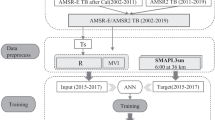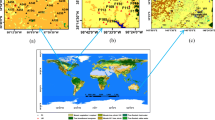Abstract
A summer 2021 European airborne field campaign—the Land surface Interactions with the Atmosphere over the Iberian Semi-arid Environment (LIAISE) campaign—presented an opportunity to explore passive soil moisture sensing with footprints as small as 100 × 200 m, contributing a key measurement to LIAISE and providing a valuable opportunity to gain detailed insight into the water/energy/carbon exchanges at such plot-scale resolution over a 17 × 5 km area. NASA Goddard’s Scanning L-band Active Passive (SLAP) sensor—an airborne simulator of the Soil Moisture Active Passive (SMAP) satellite—made nine soil moisture flights near Lleida, Spain, during 15–29 July. Soil moisture imagery and histograms demonstrate sensitivity to spatial and temporal patterns spanning irrigated and non-irrigated areas and their response to both irrigation and precipitation events followed by drydowns. Comparisons with point-scale ground truth at two sites—one within the irrigated zone and one in the non-irrigated zone—are good. Soil moisture differences are within the error bars of the ground truth values and within one standard deviation of the SLAP moisture values except for the afternoon flight of July 24. The overly dry retrieved values of that flight were likely the result of the extremely dry surface conditions and the simplified uniform ancillary data values used for this analysis. Future analyses using higher-fidelity ancillary data will explore these differences.








Similar content being viewed by others
Data availability
Per NASA policy, the SLAP data products used during the current study are available from the corresponding author upon request. They will also be available at https://earth.gsfc.nasa.gov/hydro/instruments/slap/campaigns. The user is encouraged to check for the latest data versions and to consult the data descriptions available at this URL. Requests for the ground truth datasets analyzed during the current study will be forwarded by the corresponding author to the respective authors of those datasets.
References
Islam S and Engman T (1996) Why bother for 0.0001% of Earth’s water? Challenges for soil moisture research. Eos, Transactions American Geophysical Union, 77(43):420–420. https://doi.org/10.1029/96EO00290
National Academies of Sciences, Engineering, and Medicine. (2018) Thriving on our changing planet: a decadal strategy for earth observation from space. Washington, DC: The National Academies Press https://doi.org/10.17226/24938
WCRP (2023) World Climate Research Programme Grand Challenges. (accessed 2023). https://www.wcrp-climate.org/grand-challenges/grand-challenges-overview
GEWEX (2021) Global Energy and Water EXchanges (GEWEX) Science Plan (2023–2032). World Climate Research Programme, p 12. https://www.gewex.org/gewex-content/uploads/2022/11/GEWEX-science-plan-v8.pdf
Colliander A et al (2021) Validation of soil moisture data products from the NASA SMAP mission. IEEE J Sel Top Appl Earth Obs Remote Sens 15:364–392. https://doi.org/10.1109/JSTARS.2021.3124743
Adbar (2013) Spain Hydrography River Basins.svg ETOPO1 Relief Model Rivers and river basins. Ministry of Agriculture of Spain. Wikipedia. https://commons.wikimedia.org/w/index.php?curid=24543035
Entekhabi D, Njoku EG, O’Neill PE, Kellogg KH, Crow WT, Edelstein WN, Entin JK, Goodman SD, Jackson TJ, Johnson J, Kimball J (2010) The soil moisture active passive (SMAP) mission. Proc IEEE 98(5):704–716. https://doi.org/10.1109/JPROC.2010.2043918
Piepmeier JR, Focardi P, Horgan KA, Knuble J, Ehsan N, Lucey J, Brambora C, Brown PR, Hoffman PJ, French RT, Mikhaylov RL (2017) SMAP L-band microwave radiometer: instrument design and first year on orbit. IEEE Trans Geosci Remote Sens 55(4):1954–1966. https://doi.org/10.1109/TGRS.2016.2631978
Mohammed PN, Aksoy M, Piepmeier JR, Johnson JT, Bringer A (2016) SMAP L-band microwave radiometer: RFI mitigation prelaunch analysis and first year on-orbit observations. IEEE Trans Geosci Remote Sens 54(10):6035–6047
Chan SK, Bindlish R, O’Neill PE, Njoku E, Jackson T, Colliander A, Chen F, Burgin M, Dunbar S, Piepmeier J, Yueh S (2016) Assessment of the SMAP passive soil moisture product. IEEE Trans Geosci Remote Sens 54(8):4994–5007. https://doi.org/10.1109/TGRS.2016.2561938
Mo T, Choudhury BJ, Schmugge TJ, Wang JR, Jackson TJ (1982) A model for microwave emission from vegetation-covered fields. J Geophys Res 87(C13):11229–11237. https://doi.org/10.1029/JC087iC13p11229. (AGU)
Mironov V, Kerr Y, Wigneron J, Kosolapova L, and Demontoux F (2013) “Temperature- and texture-dependent dielectric model for moist soils at 1.4 GHz.” in IEEE Geosci Remote Sens Lett 10(3):419–423. https://doi.org/10.1109/LGRS.2012.2207878
Delta-T Devices (1998) ThetaProbe ML2 user manual. Delta-T Devices Ltd, Cambridge, England, p 16
Colliander A, Fisher JB, Halverson G, Merlin O, Misra S, Bindlish R, Jackson TJ, Yueh S (2017) Spatial downscaling of SMAP soil moisture using MODIS land surface temperature and NDVI during SMAPVEX15. IEEE Geosci Remote Sens Lett 14(11):2107–2111
Colliander A, Cosh MH, Misra S, Jackson TJ, Crow WT, Powers J, McNairn H, Bullock P, Berg A, Magagi R, Gao Y (2019) Comparison of high-resolution airborne soil moisture retrievals to SMAP soil moisture during the SMAP validation experiment 2016 (SMAPVEX16). Remote Sens Environ 227:137–150
Delwart S, Bouzinac C, Wursteisen P, Berger M, Drinkwater M, Martin-Neira M, Kerr YH (2008) SMOS validation and the COSMOS campaigns. IEEE Trans Geosci Remote Sens 46(3):695–704
Jackson TJ, Bindlish R, Cosh MH, Zhao T, Starks PJ, Bosch DD, Seyfried M, Moran MS, Goodrich DC, Kerr YH, Leroux D (2011) Validation of Soil Moisture and Ocean Salinity (SMOS) soil moisture over watershed networks in the US. IEEE Trans Geosci Remote Sens 50(5):1530–1543
Panciera R, Walker JP, Jackson TJ, Gray D, Tanase MA, Ryu D, Monerris A, Yardley H, Rüdiger C, Wu X, Gao Y, Hacker J (2014) The Soil Moisture Active Passive Experiments (SMAPEx): towards soil moisture retrieval from the SMAP mission. IEEE Trans Geosci Remote Sens 52(1):490–507
Ye N, Walker JP, Wu X, de Jeu R, Gao Y, Jackson TJ, Jonard F, Kim E, Merlin O, Pauwels V, Renzullo LJ, Rüdiger C, Sabaghy S, von Hebel C, Yueh SH, and Zhu L (2021) The soil moisture active passive experiments: towards calibration and validation of the SMAP Mission. Remote Sens Environ 59(4).https://doi.org/10.1109/TGRS.2020.3007371
Dall’Amico JT, Schlenz F, Loew A, Mauser W (2011) First results of SMOS soil moisture validation in the upper Danube catchment. IEEE Trans Geosci Remote Sens 50(5):1507–1516
Loew A (2008) Impact of surface heterogeneity on surface soil moisture retrievals from passive microwave data at the regional scale: the Upper Danube case. Remote Sens Environ 112(1):231–248
Sanchez N, Martínez-Fernández J, Scaini A, Perez-Gutierrez C (2012) Validation of the SMOS L2 soil moisture data in the REMEDHUS network (Spain). IEEE Trans Geosci Remote Sens 50(5):1602–1611
Acknowledgements
The authors wish to thank the NASA Langley Research Services Directorate and the NASA Terrestrial Hydrology Program for their support of the SLAP deployment. The authors also wish to thank Aaron Boone, Belén Marti, Joaquim Bellvert, Michel Le Page, Mehrez Zribi, Pere Quintana, and Oscar Hartogensis for contributing ground truth data.
Funding
This work was supported by the NASA Terrestrial Hydrology Program.
Author information
Authors and Affiliations
Contributions
EK, AW, and HI contributed to the design, construction, and calibration of SLAP. They also deployed SLAP with colleagues from NASA Langley. All authors contributed to the algorithms and data processing. EK wrote the manuscript text, and all authors contributed to the figures and tables. All authors reviewed the manuscript.
Corresponding author
Ethics declarations
Competing Interests
The authors declare no competing interests.
Additional information
Publisher's Note
Springer Nature remains neutral with regard to jurisdictional claims in published maps and institutional affiliations.
Rights and permissions
About this article
Cite this article
Kim, E., Wu, A., Izadkhah, H. et al. High-Resolution Soil Moisture—a European Airborne Campaign Using NASA Goddard’s Scanning L-Band Active Passive (SLAP). Remote Sens Earth Syst Sci 6, 309–321 (2023). https://doi.org/10.1007/s41976-023-00099-4
Received:
Revised:
Accepted:
Published:
Issue Date:
DOI: https://doi.org/10.1007/s41976-023-00099-4




